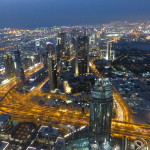
Most people think of Dubai in one way, as a fantasy world of glitz and glamor. With its tall buildings trying to outdo each other in peculiarity, its world-topping skyscrapers and shopping malls, and its outlandish man-made islands, Dubai delivers what it promises. But we found it all a bit hollow.
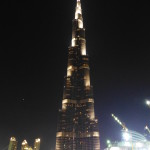
The iconic image of gleaming Dubai is what we started calling the Strip. The Strip is a three kilometer long highway of 8 to 10 lanes in central Dubai, lined by two rows of tall buildings – a mix of offices, hotels, clubs and apartments.
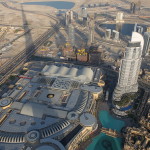
On the southwest end of the Strip rises the world’s tallest building, the sleek stiletto of the Burj al Khalifa, whose observation deck on the 124th floor seems pretty high until you realize that there’s still 45% more of the building above you. As the sun sets and the Burj casts its sundial-like shadow over the town, the lights of the Strip and its night-time activity begin to sparkle impressively.
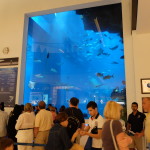
At the base of the Burj al Khalifa squats the largest shopping mall in the world. The Dubai Mall offers three sprawling levels of consumerism along with fashionable entertainment that includes a multi-story aquarium, a huge virtual experiences hall and an ice-skating rink. Daily tens of thousands visitors throng the shops and eateries within the Mall. Or they can cross the sizable artificial lake between the Mall and the tower via an ersatz Rialto bridge to shop locally grown souvenirs at an imitation of a traditional souk market. Or they can enjoy the evening’s spray-and-light show on the lake every 20 minutes or so.
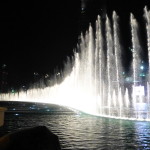
The restaurants with large decks facing the lake offer some some classy dining options, but most of the Mall’s food choices seem unimpressively familiar: Texas Roadhouse, PF Changs, California Pizza Kitchen, Red Lobster, along with fast fooders like Nando’s (roasted chicken chain big in Asia and Oceania), Fatburger, Subway, Johnny Rockets, KFC, Burger King, Rainforest Cafe, Cheesecake Factory, and TGIFriday’s. We were not impressed.

Even the Strip left us with mixed feelings. Though it’s not really intended for walking, we did stroll it during the day. We saw some striking buildings, many of which come in doubles. Two wedges atop reflective glass skyscrapers over here. A doubled set of new high-rises connected by a tubular walkway over there. Even low lying residential buildings seemed to come in pairs. We were also surprised, since the Strip seemed so full already, to find newer, taller, more unusual structures filling in old spaces or entirely new sections nearby. Otherwise, at street level, most of the walk is fairly dull and uninviting – lots of service entrances, parking areas, and few shops.
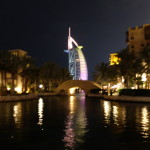
Far from the Strip, other malls and attractions beckon. A few kilometers away, the Madinat Jumeirah mall consists of a confusing set of building blocks, with restaurants somewhat more interesting than those at the Dubai Mall arrayed around another artificial lake. Pacha, the glitziest of these, even refused us entry on a quiet night because our Keen sandals did not meet their footwear requirements. Nearby is the sail-shaped Burj al Arab, a flashy hotel on the oceanfront with a reservations-only dining spot near its top.

Perhaps capping them all in allure, is the Palm Jumeirah, reputedly the largest landfill in the world and, yes, palm-shaped. The trunk of the palm juts out into the water for about four kilometers. Flanking the trunk roadway are two rows of medium-rise apartment buildings for the wealthy. At regular intervals, side roads arc out from the trunk, “fronds” of the palm, each of which contains individual homes with their own beach fronts. At the top of the trunk, an 11 kilometer long, crescent-shaped frond draws most of the tourists to its resort hotels and an oceanfront walkway for gawkers. The largest resort is the showcase Atlantis Hotel stuffed with 1500 rooms, a water park, its own aquarium and a marine park. At one end of the crescent, the posh One and Only sits apart, a lot more quietly situated. Other resorts are still being built.
In the works is a similar landfill between Palm Jumeirah and the Strip, where a set of islands form a rough global map of the continents.
As the playground of the UAE and the Arabian Peninsula, Dubai’s party goes on. Perhaps many who come are expats in the region in search of comfort foods and goods. Perhaps the UAE residents and their Arabian neighbors just want to enjoy an outsized version of western lifestyles at home – with a sense that they’re going one better than the west. The malls and clubs keep drawing tourists and those with business here. It’s the place to shop and play…and then shop some more; a place to loosen the strictures of religion or custom; a place to offer the best of the western world; a place to exceed the aspirations of the west.
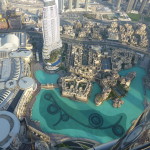
But we kept wondering where or when it will all end. During our walkabout, one of the buildings we passed was the Dubai World Trade Center at the northeast end of the Strip, with a host of adjacent buildings to serve conventioneers. It reminded us that there is some real business being conducted here, not just in these buildings but also in the huge set of office structures circling the waterway called Business Bay at the other end of the Strip. As the seat of the UAE government, Abu Dhabi may be more important for business, but there’s plenty going on here in energy resources, construction, finance and so on.
Despite this ongoing business and the continued construction of grander delights in Dubai, we detected some disquiet. There seems to be a growing anxiety underlying all the exuberance. Many now foresee the end of the ride, with less and less wealth literally flowing into the UAE when its natural resources in oil and gas become depleted or not so valuable.
Then will all that excess of tourist pleasures be enough attraction? Western tourists should have plenty of such craziness back home, as would visitors and business people from most large Asian cities. The glitter, we thought, of showy consumerism and excess would eventually tarnish.
It certainly didn’t take long for us to have our fill of this side of Dubai. Its other face began to appeal to us more and more – the mundane, drab day-to-day city that locals know very well, and tourists rarely see.

On the north side of the Strip, in the two kilometer span over to the Persian Gulf, older neighborhoods fill in the rectilinear streets with drab two and three story sand-colored buildings, served by local shops. Though hardly noticed by visitors up on the Burj al Khalifa, these actually comprise the bulk of the city’s space. Here is where the middle class of the UAE and all its workers live.
We stayed in the district of Bur Dubai toward the northeast, another middle class section of town. The buildings on the main streets had the jammed look and clutter of Asian cities, but all was clean and fresh, with a host of banks amid the retail and even some well-spaced mid-rise offices. Apartment buildings filled the side streets, uninteresting in themselves but neat and tidy. Even here there was a mall, with a large parking lot, filled with a lot of shops to serve the working class rather than the tourists. The largest store was a huge Carrefour grocery and department store from the French chain. It offered the shoppers, who were mainly local, a myriad of dry goods, canned and chilled products, as well as fresh produce and meats that rivaled any store we’ve seen in the west. In the deli section alone, dozens of olive options, eight different feta cheeses, mangoes from 7 different regions or countries, and acres of breads tempted buyers. Carrefour even has people eating French style, with lots of packaged products from the home country.
We preferred the much more modest sized neighborhood grocery, but even there most of the produce was recognizable, and many of the packaged goods virtually identical to things available in the US. Had we actually left?
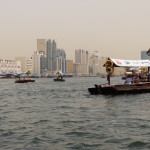
Bur Dubai clearly caters to its well-to-do residents, not ostentatiously, but with solid middle-class style and variety. Just north, via a flat-boat water taxi ride across the wide Dubai River costing just a few pennies, is the much less stylish neighborhood of Deira, where the real working class residents live.
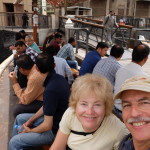
Many of the people living here comprise the other half of Dubai’s residents, those several million non-citizens drawn from countries like India, Pakistan, the rest of the Middle East and Africa to do the hardest work here. They also include the Europeans – like the people from Romania, Ukraine, France – or from the Philippines we met on our one night at Madinat Jumeirah mall. All of them are here to do the hard work that keep the bright lights of the glamorous side of Dubai lit.
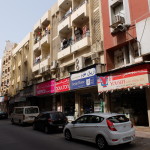
In Deira, the narrow streets filled with countless five story buildings (retail below, residential above) were still clean and pleasant, but with little flair and lots of bustle. Most of the goods were low end housewares and such, but this area was intensely mercantile. Different sections concentrated on different kinds of things. Several blocks were dedicated to uniforms and hardware items; other blocks for household items like pots and plates; there was a paper products section.
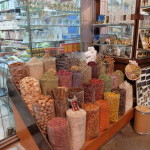
Jewelry merchants dominated yet another set of streets, offering all sorts of inexpensive bling. Small convenience stores and street stalls sold groceries; no Carrefour in sight. In another section, many merchants sold pulses and dry beans from sacks, often artfully displayed. There were few tourists around, but apparently Russians really like this area. A lot of the storefronts displayed Russian invites to come and shop.
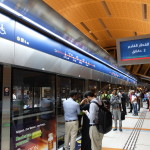
After we wandered Deira, we took the shiny new Metro back to Bur Dubai, and then later into the heart of the Strip. On the trains were the tourists headed to one of the glamor spots of town and office workers out for a night on the town. When we returned, most of the passengers – the workers apparently – were headed sleepily back home to their neighborhoods. Over-saturated with the glitz of Dubai, we were pleased to be among them, far away from the fantasy world uptown.
(Also, for more pictures from UAE and Oman, CLICK HERE to view the slideshow at the end of the UAE-Oman itinerary page.)


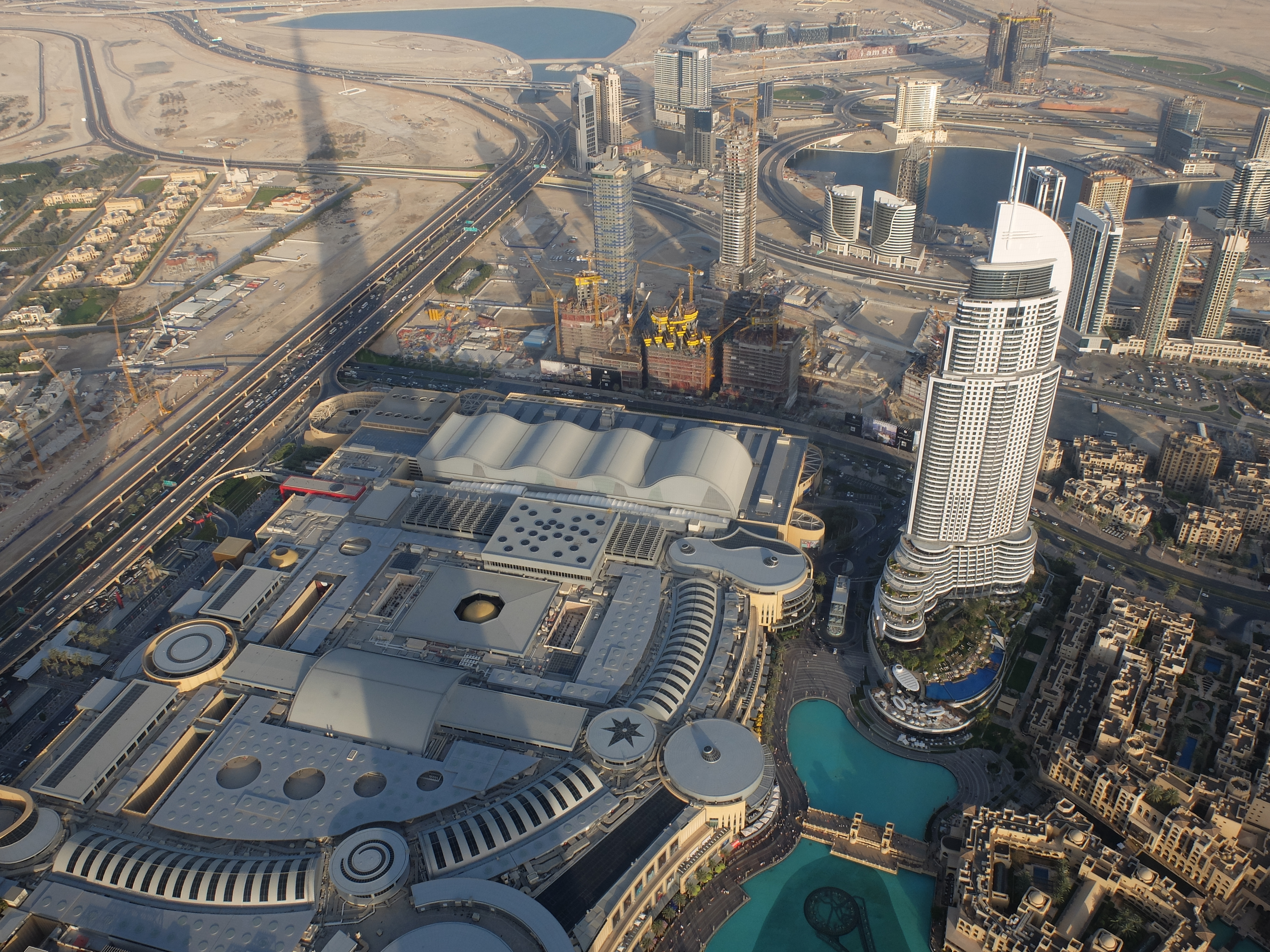
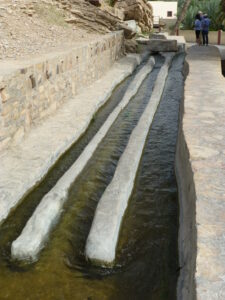
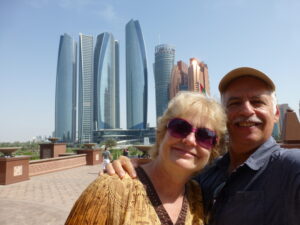
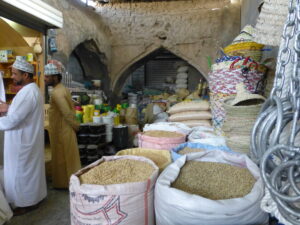
I agree with this whole statement.